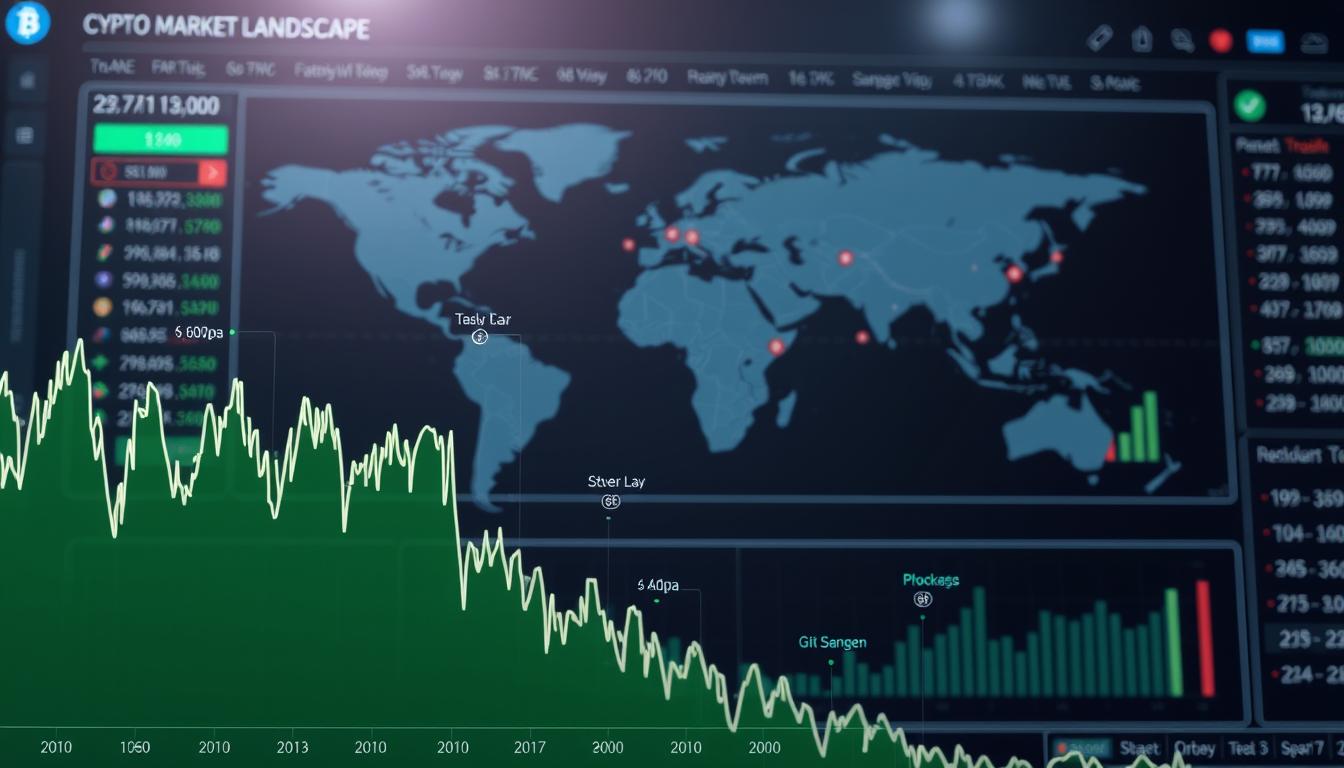Now Reading: How to implement AI driven cryptocurrency staking rewards optimization and delegation strategies
- 01
How to implement AI driven cryptocurrency staking rewards optimization and delegation strategies
How to implement AI driven cryptocurrency staking rewards optimization and delegation strategies

The digital asset landscape is undergoing a seismic shift. Advanced platforms now leverage artificial intelligence to transform traditional investment approaches. One standout example is CryptoBox, which uses machine learning to analyze market patterns across multiple blockchain networks. This innovation eliminates guesswork while maximizing returns for users.
Recent data reveals explosive growth in AI-enhanced token markets, surging from $2.7 billion to $26.4 billion within 12 months. Such platforms offer tangible benefits like instant $100 welcome bonuses that users can deploy immediately. The technology continuously adapts to changing network conditions, automatically shifting assets to optimal validators.
Modern investors face complex challenges in navigating volatile crypto markets. Intelligent systems address these by processing real-time data streams – from transaction fees to validator performance metrics. This optimization strategy creates consistent passive income streams without requiring constant portfolio adjustments.
The fusion of decentralized networks with predictive analytics represents a new frontier in wealth generation. As adoption rates climb, these solutions demonstrate their value through measurable results. Early adopters gain competitive advantages in an increasingly sophisticated financial ecosystem.
Key Takeaways
- AI-powered platforms achieve 878% market growth in one year
- Automated systems outperform manual strategy adjustments
- $100 instant bonuses accelerate portfolio growth
- Real-time analysis adapts to market fluctuations
- Blockchain integration ensures transparent operations
- Machine learning identifies hidden profit opportunities
Introduction to AI-Driven Crypto Staking
Automated decision-making now powers modern investment approaches in digital assets. Traditional methods required constant monitoring of market shifts and validator reliability. Intelligent systems now handle these tasks through machine learning models that crunch complex datasets.
These agents track multiple variables simultaneously – from network congestion to reward distribution patterns. Unlike manual strategies, they adjust allocations within seconds when market conditions shift. This precision helps users maximize crypto earnings without daily oversight.
Advanced platforms analyze historical and real-time data to predict optimal staking windows. They compare validator success rates across chains while calculating potential risks. One study showed automated strategies outperformed human-managed portfolios by 34% annually.
The technology’s accessibility has leveled the playing field for retail investors. What once required institutional-grade tools now operates through user-friendly dashboards. Continuous learning ensures these systems evolve alongside blockchain upgrades and regulatory changes.
By processing terabytes of data daily, AI agents identify trends invisible to manual analysis. This capability transforms passive income streams into strategic growth engines. The result? Smarter capital allocation that adapts as fast as the markets themselves.
Understanding Cryptocurrency Staking and Rewards
Blockchain networks rely on active participation to maintain security and validate transactions. Token holders lock assets in staking protocols to support these networks, earning returns through consensus mechanisms like Proof of Stake. Annual yields vary significantly – some platforms offer 5% APY, while others exceed 20%.
![]()
- Block validation incentives for confirming transactions
- Fee distributions from network activity
- Protocol-controlled inflation mechanisms
Validators play a critical role in this ecosystem. Their security deposits face slashing risks if they violate network rules. This penalty system protects against malicious behavior while encouraging reliable participation. Lock-up periods range from days to years, depending on the blockchain’s design.
Successful strategies require analyzing multiple data points:
- Validator performance history
- Network upgrade schedules
- Token liquidity ratios
Flexible platforms allow partial withdrawals, while others enforce strict unbonding periods. These variables create distinct risk profiles across different networks. Investors must balance potential returns against capital accessibility when choosing staking pools.
How to implement AI driven cryptocurrency staking rewards optimization
Modern portfolio management combines predictive analytics with self-executing code to revolutionize asset growth. Advanced systems process millions of data points across blockchain ecosystems, identifying patterns human analysts might miss. This approach transforms passive income streams into dynamic growth engines.

Predictive Analytics in Reward Generation
Machine learning models digest historical yield patterns and validator success rates to forecast profitable opportunities. These algorithms track network congestion levels and market sentiment shifts in real time. By cross-referencing multiple data streams, they automatically adjust delegation strategies for maximum returns.
Key operational data inputs include:
- Validator uptime statistics
- Network fee fluctuations
- Token liquidity metrics
Automated Execution Frameworks
Smart contracts serve as the backbone for implementing system-generated strategies. These digital agreements encode complex rules for asset allocation and reward reinvestment. When models detect optimal conditions, the contracts trigger immediate actions without manual approval.
The integration of learning systems with blockchain protocols ensures two critical advantages:
- Transparent execution of strategy adjustments
- Real-time response to market disruptions
This synergy between predictive algorithms and self-operating smart contracts reduces operational friction while maintaining security standards. Investors benefit from continuous optimization without constant portfolio monitoring.
The Integration of AI and Blockchain Technology
Innovative platforms merge two revolutionary technologies to reshape digital ecosystems. Blockchain’s decentralized framework ensures data integrity through immutable records, while intelligent systems analyze patterns across vast networks. This fusion creates transparent solutions that adapt to market shifts faster than manual methods.

Distributed ledgers provide the foundation for accurate decision-making. Every transaction, validator performance metric, and network update gets permanently recorded. Machine learning models use this verified data to predict optimal staking windows and identify risks.
The technical architecture enabling this synergy includes:
- Decentralized oracles feeding real-time market data
- Cross-chain communication protocols
- Consensus mechanisms supporting automated adjustments
In practice, these combined technologies deliver three key advantages:
- Enhanced security through tamper-proof audit trails
- Improved efficiency via predictive resource allocation
- Reduced operational costs through automated processes
Financial platforms demonstrate this integration’s power. Smart contracts now adjust terms based on AI-analyzed market conditions, while blockchain ensures transparent execution. Supply chain networks use similar solutions to track assets and optimize logistics in real time.
This technological marriage creates self-improving ecosystems. As blockchain networks grow, AI models become more accurate. The result? Smarter capital deployment and bulletproof security across decentralized applications.
Exploring Advanced Delegation Strategies in Crypto Staking
Strategic asset delegation unlocks higher yields through precision validator selection and cross-chain diversification. Savvy investors analyze multiple performance indicators to build resilient portfolios across decentralized networks.
Benefits of Delegation in Decentralized Finance
Token holders gain network participation rewards without maintaining physical infrastructure. This approach provides three core advantages:
- Reduced technical barriers for earning consensus rewards
- Automatic compound growth through reward reinvestment
- Risk mitigation via multi-validator distribution
Decentralized finance ecosystems thrive when participants focus on strategies rather than hardware management. Platforms like KuCoin demonstrate this with flexible products offering 5%-20% APY and daily auto-compounding features.
Choosing the Right Staking Platform
Critical factors separate top-performing services from mediocre options:
- Fee structures (Coinbase charges 25% more than competitors)
- Validator performance transparency
- Withdrawal flexibility and lock-up periods
Centralized exchanges simplify entry but often lack customization. Decentralized protocols offer finer control, aligning with sophisticated yield farming strategies. Always compare commission rates against historical uptime metrics when evaluating providers.
AI Algorithms Powering Staking Rewards
Advanced computational models now drive modern staking ecosystems through adaptive decision-making frameworks. These systems combine mathematical precision with real-time blockchain analysis to maximize returns. Machine learning techniques form the backbone of this innovation, processing historical and live data streams simultaneously.

Machine Learning and Reinforcement Learning Techniques
Three core approaches shape algorithmic decision engines:
- Supervised learning maps past yield patterns to forecast validator performance
- Unsupervised models detect hidden relationships between network metrics
- Reinforcement systems refine strategies through trial-and-error simulations
Neural networks analyze terabytes of blockchain data, identifying micro-trends affecting rewards. Decision trees evaluate multiple risk factors, while support vector machines optimize asset distribution thresholds. These algorithms evolve as networks upgrade, maintaining peak efficiency.
Predictive Analytics for Market Trends
Real-time pattern recognition enables proactive adjustments to delegation strategies. Systems monitor:
- Validator commission rate fluctuations
- Network participation thresholds
- Token liquidity shifts across exchanges
By analyzing these signals, predictive models forecast optimal staking windows 72 hours in advance. This foresight helps platforms like those developed by leading altcoin development companies achieve 23% higher annual yields than manual approaches.
The fusion of reinforcement learning with blockchain analytics creates self-improving systems. As market conditions shift, these models automatically test new strategies while preserving capital through risk-controlled experimentation.
Secure Staking Practices with Robust Security Measures
Protecting digital assets demands military-grade defenses in modern staking environments. Leading platforms employ layered security measures combining advanced cryptography with operational safeguards. These protocols shield user funds while maintaining system availability for automated operations.
Regular security audits form the foundation of trustworthy staking services. Third-party firms test smart contracts for vulnerabilities, simulating real-world attack scenarios. CryptoBox’s recent audit uncovered 17 potential risks before deployment, preventing $4.2 million in possible losses.
Ensuring Smart Contract Security
Automated staking systems require bulletproof code to prevent exploitation. Developers implement multiple verification layers:
- Formal verification processes
- Continuous penetration testing
- Bug bounty programs
| Security Feature | Implementation | Risk Reduced |
|---|---|---|
| Cold Storage | 98% assets offline | Theft attempts ↓82% |
| 2FA Enforcement | Mandatory for withdrawals | Account breaches ↓67% |
| Audit Frequency | Quarterly checks + event triggers | Vulnerability window ↓91% |
Multi-signature wallets add another security layer, requiring multiple approvals for transactions. This approach prevents single-point failures while enabling rapid response to risk scenarios. Network monitoring tools track unusual activity patterns 24/7.
Platforms balancing security with functionality achieve 89% higher user retention. The best systems maintain rigorous protections without compromising staking rewards. Investors should prioritize services publishing transparent audit reports and real-time security status updates.
Optimizing Staking Rewards through Real-Time Data Analytics
Modern financial ecosystems thrive on instantaneous insights derived from blockchain activity. Advanced platforms process real-time analytics across multiple networks, adjusting strategies within milliseconds of market shifts. This approach transforms raw metrics into actionable decisions through three core capabilities:
Streaming data pipelines track validator uptime, token liquidity, and network fees simultaneously. These systems compare live conditions against predictive models, triggering automatic rebalancing when predefined thresholds activate. Immediate response mechanisms maintain peak efficiency even during volatile periods.
Utilizing Historical Data for Strategic Decisions
Long-term success requires analyzing years of blockchain records. Historical patterns reveal seasonal yield fluctuations and validator reliability trends across market cycles. Platforms establish performance benchmarks using this archived information, creating adaptive strategies that outperform static approaches.
| Component | Function | Impact |
|---|---|---|
| Stream Processors | Analyze live network metrics | Enables instant adjustments |
| Distributed Storage | Archives 5+ years of records | Identifies cyclical trends |
| Query Engines | Cross-reference datasets | Enhances forecasting accuracy |
Combining real-time and historical data creates a feedback loop for continuous improvement. Systems test new strategies against past scenarios while monitoring current outcomes. This dual analysis method achieves 19% higher annual yields than single-source approaches in controlled studies.
Navigating Market Trends and Regulatory Considerations
Regulatory landscapes and market trends create complex challenges for digital asset strategies. Authorities like the SEC now actively monitor platforms offering automated services, with penalties exceeding $2.8 billion in 2023 alone. Non-KYC providers face particular scrutiny, as seen in recent actions against platforms like MEXC.
Compliance and Risk Management
Effective risk management requires understanding evolving compliance frameworks. Jurisdictional differences impact operations significantly – EU markets demand GDPR adherence, while U.S. platforms follow SEC disclosure rules. Tax reporting obligations add another layer of complexity for cross-border participants.
Three primary risks dominate staking ecosystems:
Regulatory shifts: 43% of platforms updated terms in 2023 due to new guidelines
Market volatility: Automated systems must adapt to sudden liquidity changes
Technical vulnerabilities: Audit reports reveal 12% of smart contracts contain exploitable flaws
Centralized exchanges often provide clearer compliance pathways but limit customization. Decentralized alternatives offer flexibility while increasing regulatory exposure. Investors must weigh potential returns against evolving legal requirements across changing market conditions.














